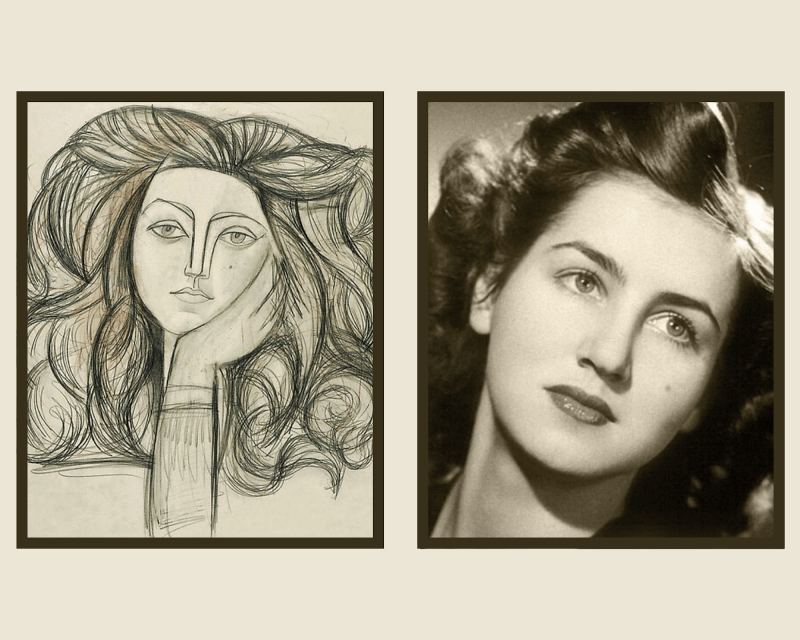I came across a series of Picasso’s drawings of his lover, Francoise Gilot, and was riveted by the teeming world of life behind her composed facade. While her face is simply rendered, her hair explodes around it with Medusa’s allure. She is marvelously handsome, with a charming frankness captured by that angular nose. Picasso expertly uses two straight, brusque lines to give her face direction, and to gather its boldness, its solemnity and its touch of gentleness into a point. That piquantly arched eyebrow is the only flirting flavor about her, submerged beneath a quiet, pensive attitude. Her eyes are perhaps tired, perhaps resigned, yet never lacking an observant quality to them, which brings her to life. Above all, her hair is striking. Her hair (!) sweeping, roaring, winding, with strands half as if they are conniving with one another, half exuding indulgently with magical realism in this otherwise sober drawing. Tangled strokes of the pencil flirt with the imagination.
Her beauty, as captured in the drawing, is of a kind that opens my heart, even in the current state of confinement.
Francoise Gilot was 21 when she met 61-year-old Picasso at a cafe in Paris. Sitting at another table with his soon-to-be-discarded lover, Dora Maar, Picasso was immediately drawn to Gilot. He famously came over to her table with a bowl of cherries and introduced himself. For almost 10 years, they lived together in the French countryside and had two children, although they never married. She is the only woman to ever leave Picasso, reflecting on their affair as a “catastrophe I didn’t want to avoid.”
She, too, was and still is a remarkable painter. Picasso commented that she was too beautiful to be a painter upon their first meeting in the cafe; Gilot, although her work was influenced by Picasso, has always preferred Matisse’s style over Picasso’s. Admittedly, I feel guilty for identifying her as “Picasso’s lover,” as most writing about her has, since she has an entirely fascinating oeuvre apart from him, but his portraits of her touched me so.
Having drastically gone through the process of abstraction between this drawing and the previous one, Picasso nonetheless preserves Francoise’s air of mystery underneath her startling frankness. He has maintained the arched eyebrow, the nose, the eyes, even the delicate cleft in her chin. With her features outlined in a similar manner, the main act of abstraction is in her hair and neck. Rather than billow, her hair drapes. Along with the elongated and rectangular neck, the drawing unfolds vertically to render her elegance the most striking.
A garland wrapped around her head takes on the wild quality of her hair as an unrestrained moment of affect. It recalls Greco-Roman aesthetics, and is one of many traces of classical influence in Picasso’s works. Perhaps due to his training in classicism, he has demonstrated strong skills in portraiture since a young age, which allows him to depict the human form with such effortlessness as seen in this drawing.
After visiting Matisse, whose work Gilot most admired as a young artist, Picasso painted this portrait of her. Jealous of Matisse’s description of how he would depict Gilot in a blue-green palette, Picasso took on that color-scheme to paint her himself. The yellow-blue-green combination would be uniquely assigned to her since. With leaves surrounding her face atop a stem-like figure, she undergoes an abject metamorphosis into a flower. Picasso does not use color with the same saturation that Matisse would have. The irksomely pale yellow supporting her light blue body lends to Gilot a cold distance that was already somewhat present in the two previous drawings. An ethereal air still lingers in her form of precariously stacked, slender triangles that float upward with levity. This magical infusion continues in the dark green leaves framing her face that hold most of the weight in the painting. Similar to her twining hair in the first drawing and garland in the second, the leaves’ dynamic growth in all directions enraptures me and provokes a well of feeling within me. The green’s occasional plunging into black holds infinite mystery that draws me closer.
Balancing an elegance and composure that veers towards coldness, Gilot’s endlessly imaginative character pierces through with a fiery magic.
Contact Betty He at hebetty ‘at’ stanford.edu.
